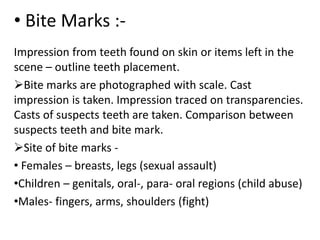Samples used in Forensic Odontology
- 1. VARIOUS SAMPLES USED IN FORENSIC ODONTOLOGY PRESENTED BY :- ALISHA KARMALI
- 2. ŌĆó Why Teeth? I. Each individual has individual set of teeth which can be traced back to establish dental records. II. Teeth are a source of DNA, dental pulp or crushed tooth can provide nuclear or mitochondrial DNA to help identify that person.
- 3. ŌĆó When is Dental Identification used? I. To identify human remains that cannot be identified using face recognition, fingerprint or other means. II. Identify bodies in mass fatalities (e.g. plane crashes) III. Determine the source of bite mark injuries (assault or suspected abuse ŌĆō sexual assault, child abuse, personal defense situations) IV. Estimate age and sex of skeletal remains. V. Testify in case of dental malpractices. VI. Other methods ŌĆō Cheiloscopy (study of lip prints), Rugoscopy (study of palate rugae patterns), Sialochemistry (detection of chemicals in saliva).
- 4. ŌĆó Post Mortem dental profiling :- I. It includes descendants ŌĆō ethnic origin, gender, age. II. Race Determination (country of residence) ŌĆō Treatment quality. III. Sex determination ŌĆō teeth are generally smaller in females (mesio-diatal and bucco-lingual dimensions). Canines show max. sex difference- being larger in males. ŌĆó By DNA analysis ŌĆō Y chromosome from dental pulp after 1yr of death. From Amelogenin ŌĆō enamel protein located on X and Y chromosome. Barr bodies and x-chromosome of female detected on buccal mucosa epithelium.
- 5. ŌĆó Identification from Dental DNA : Teeth ŌĆō Excellent source of DNA PCR (polymerase chain reaction) ŌĆō amplifies highly degraded DNA. Types of DNA- 1. Genomic or Nuclear DNA (commonly used) 2. Mitochondrial DNA
- 6. ŌĆóExtraction of Dental DNA :- CRYOGENIC GRINDING ŌĆō Coding the whole tooth to extremely low temperature using liquid nitrogen and grinding to fine powder. Less destructive method is drilling the root canals and scrapping pulp area.
- 7. ŌĆó Bite Marks :- Impression from teeth found on skin or items left in the scene ŌĆō outline teeth placement. ’āśBite marks are photographed with scale. Cast impression is taken. Impression traced on transparencies. Casts of suspects teeth are taken. Comparison between suspects teeth and bite mark. ’āśSite of bite marks - ŌĆó Females ŌĆō breasts, legs (sexual assault) ŌĆóChildren ŌĆō genitals, oral-, para- oral regions (child abuse) ŌĆóMales- fingers, arms, shoulders (fight)
- 9. ŌĆó Computer Odontology - I. Automatic dental code matching ŌĆō bites run through search to find a match II. Odontosearch ŌĆō compare on bases of missing peoples. III. Automatic dental identification system ŌĆō list of people who have the same dental code number. IV. 3D bite mark analysis ŌĆō used to generate overlays with various pressure and deviations. Overlays compared with bite marks.
- 10. ŌĆó Saliva :- It is a major source of DNA because it cantains sloughed epithelial cells from oral mucosa and inner surface of lips. Enzymes present in saliva and teeth ŌĆō Streptococcus Salivaricus PCR provides means to identify the bacterial composition from bite marks and can be matched exclusively to those from the teeth responsible.
- 11. Blood :- ŌĆó Red blood cells do not have any DNA, as they lose their nuclei (the compartment in a cell that contains the DNA) as they mature. ŌĆó So the DNA in your blood is in your white blood cells. To get at it, scientists first spin a small sample of your blood at high speed, to separate the cells from the blood fluid.











